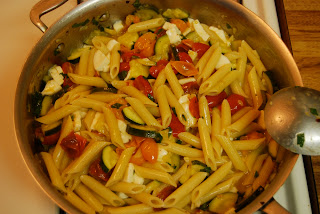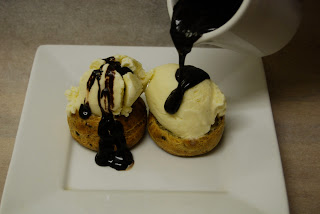“Hot town, Summer in the City,”
Zucchini
and Cherry Tomatoes with Penne
This is a quick and easy pasta using a few fresh ingredients
from the farmers market, one that doesn’t demand too much effort when it’s hot,
but it beats take-out. The
vegetables simmer together and create the sauce that is ready in about the same
time it takes the pasta to cook. While this uses penne, you could use your
favorite variety of pasta. You could also use a different fresh herb.
You could also do this with eggplant. If you do, peel (or
don’t peel) the eggplant and dice it into equal sized pieces. You’ll want 2
cups. Eggplant soaks up a lot of
oil when its cooked, so this method of precooking the eggplant in the oven* uses
less oil. Place the diced eggplant into a bowl. Mix the eggplant with a few
tablespoons oil, and season with salt and ground black pepper. Spread the
eggplant out in one layer on a baking sheet lined with a sheet of parchment or
a silicon mat (a non-stick pan will work, too). Roast the eggplant in a 350
degree oven until it begins to soften, about 10 minutes depending on the size
of your eggplant pieces. If you make this with eggplant, start the sauce with
the tomatoes then add the cooked eggplant to the tomatoes.
Zucchini and Cherry Tomatoes with Penne
For three servings:
4 ½ ounces dried pasta
2 cups zucchini, sliced lengthwise into quarters, then cut
into 1/4” slices
2 cups assorted cherry tomatoes, cut in half, lengthwise
¼ cup chopped
fresh basil
4 ounces fresh mozzarella, cut into cubes
1 or 2 teaspoon chopped garlic (depending on your vampire
index)
hot pepper flakes, optional
salt and ground black pepper
olive oil for cooking
½ cup pasta
water
1. Cook the pasta in boiling salted water according to
package directions.
2. Heat a large sauté pen over medium-high heat. When the pan
is hot, swirl in 2 to 3 tablespoons olive oil. Add the zucchini; season with
some salt and pepper. Cook the zucchini for 3 to 4 minutes. Add the cherry
tomatoes and the hot pepper flakes and stir; if the pan appears dry, add a
little extra olive oil. Season the tomatoes with salt and pepper. Sauté the
tomatoes for 2 to 3 minutes, then add the garlic and stir; cook until
fragrant. Add ½ cup of the pasta
water to the pan. Reduce the heat to low, stir in the fresh basil, cover the
pan and let the vegetables simmer gently until tender, about an additional 3 to
4 minutes; if the sauce is ready before the pasta, remove the pan from the
heat. Remember, the vegetables are creating the sauce for the pasta, so don’t
let the pan dry out.
3. Drain the pasta. Add the pasta to the vegetables; gloss
the pasta with a little olive oil. Scatter the fresh mozzarella over the pasta
and stir together. Divide the pasta between three bowls and serve.
*I know. “If it’s hot outside, who wants to turn on the
oven?” but this is a good method for cooking eggplant without using so much
oil.


































